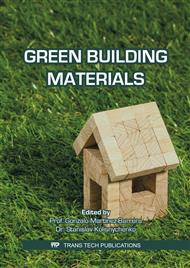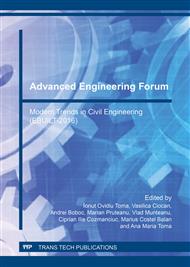[1]
E. M.J. Salentijna, Q. Zhangb, S. Amaduccic, M. Yangb, L. M. Trindadea, New developments in fiber hemp (Cannabis sativa L. ) breeding, Industrial Crops and Products 68 (2015) 32–41.
DOI: 10.1016/j.indcrop.2014.08.011
Google Scholar
[2]
G. Balciunasa, I. Pundieneb, L. Lekunaite-Lukosiunea, S. Vejelisa, A. Korjakinsca, Impact of hemp shives aggregate mineralization onphysical–mechanical properties and structure of composite withcementitious binding material, Industrial Crops and Products 77 (2015).
DOI: 10.1016/j.indcrop.2015.09.011
Google Scholar
[3]
M. Carus, L. Sarmento, The European Hemp Industry: Cultivation, processing and applications for fibres, shivs, seeds and flowers, may 2016, EIHA.
Google Scholar
[4]
C. Ingrao, A. Lo Giudice, J. Bacenetti, C. Tricase, G. Dotelli, M. Fiala, V. Siracusa, C. Mbohwa, Energy and environmental assessment of industrial hemp for building applications: A review, renewable and Sustainable Energy Reviews, 51 (2015).
DOI: 10.1016/j.rser.2015.06.002
Google Scholar
[5]
T. Buchert, S. Neugebauer, S. Schenker, K. Lindow, R. Stark, Multi-criteria decision making as a tool for sustainable product development- Benefits and obstacles, 12th Global Conference on Sustainable Manufacturing, 2015, pp.70-75.
DOI: 10.1016/j.procir.2014.07.110
Google Scholar
[6]
P. de Bruijn, Material properties and full scale rain exposure of lime-hemp concrete walls, Doctoral thesis, Alnarp, (2012).
Google Scholar
[7]
Mustafa Yilmaza, Adem Bakis, Sustainability in Construction Sector, World Conference on Technology, Innovation and Entrepreneurship, (2015).
Google Scholar
[8]
I. Preikss, J. Skujansa, A. Adamovicsb, U. Iljinsc, Evaluation of Hemp (Cannabis Sativa L. ) Quality Parameters for Building Material from Foam Gypsum Products, Chemical engineering transactions, Vol. 32, (2013).
Google Scholar
[9]
R. Brencis, J. Skujans, U. Iljins, I. Ziemelis, N. Osits, Research on Foam Gypsum with Hemp Fibrous Reinforcement.
Google Scholar
[10]
P. de Bruijn, Hemp concrets- Mechanical properties using both shives and fibres, Licentiate thesis, (2008).
Google Scholar
[11]
S. Amaducci, D. Scordia, F.H. Liu, Q. Zhang, H. Guo, Key cultivation tehniques for hemp in Europe and China, Industrial Crops and Producs, 68 (2015), pp.2-16.
DOI: 10.1016/j.indcrop.2014.06.041
Google Scholar
[12]
E. Sassonia, S. Manzia, A. Motoria, M. Montecchid, M. Cantiea, Novel sustainable hemp-based composites for application in the building industry: Physical, thermal and mechanical characterization, Energy and Buildings 77 (2014), p.219–226.
DOI: 10.1016/j.enbuild.2014.03.033
Google Scholar
[13]
D. L. Manea, A. G. Netea, Materiale de construcții și chimie aplicată, volumul II, ed. Mediamira, (2006).
Google Scholar
[14]
Information on: https: /www. scribd. com (D. Babor, Studiul materialelor de construcții).
Google Scholar
[15]
Information on : http: /www. spatiulconstruit. ro.
Google Scholar
[16]
SR EN ISO 10534-2: 2002 Acustica. Determinarea coeficientului de absorbtie Acustica si a impedantei cu interferometrul acustic.
Google Scholar
[17]
C107/3 Normativ privind calculul performantelor termoenerfetice ale elementelor de constructie ale cladirilor.
Google Scholar
[18]
SR EN 520+A1: 2010 Placi de gips-carton. Definitii, specificatii si metode de incercari.
Google Scholar
[19]
C125-2013- Normativ privind acustica in constructii si zone urbane.
Google Scholar
[20]
Laurent Arnaud, Etienne Gourlay, Experimental study of parameters influencing mechanical properties of hemp concretes, Construction and Building Materials 28 (2012), p.50–56. s.
DOI: 10.1016/j.conbuildmat.2011.07.052
Google Scholar



